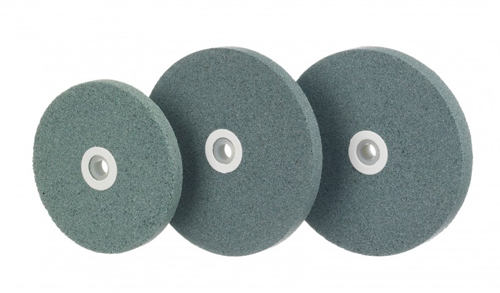
Improper use of grinding wheels may have a direct effect on machining precision, surface roughness, and production efficiency. As a result, abrasives manufacturers are supposed to choose appropriate grinding wheels according to specific situations.

There are various types of grinding wheels with different shapes and sizes, and based upon different factors, such as abrasives, materials of bonding agents, and manufacturing techniques, each kind of grinding wheels has certain scopes of application. Improper use of grinding wheels may have a direct effect on machining precision, surface roughness, and production efficiency. As a result, abrasives manufacturers are supposed to choose appropriate grinding wheels according to specific situations. Then comes the question: How to choose grinding wheels correctly?
1. Choice of abrasive types
Choice of abrasives depends on materials of workpiece and heat treatment methods. As we all know, the most frequently used abrasives are brown fused alumina and white fused alumina, next are black silicon carbide and green silicon carbide. Besides that, pink fused alumina, single crystal alumina, microcrystal fused alumina, and zirconia alumina are also used in various situations.
Brown fused alumina grinding wheels are high in hardness and toughness, suitable for grinding metal with higher tensile strength, for example, carbon steel, steel alloy, malleable cast iron, and hard bronze. Brown fused alumina is widely used for rough grinding due to its high grinding performance and adaptability.
Hardness of white fused alumina is slightly higher than brown fused alumina, while in terms of toughness, the former is lower. Abrasive grains are prone to fracture while grinding and generate less grinding heat. White fused alumina grinding wheels are designer for precision grinding of hardened steel, high carbon steel, high speed steel, etc. The cost is higher than brown fused alumina grinding wheels.
Black silicon carbide is brittle and sharp, harder than white fused alumina. Black silicon carbide grinding wheels are generally used for grinding materials with lower mechanical strength, such as cast iron, brass, aluminum and refractory materials.
Green silicon carbide abrasive grains are sharp with good thermal conductivity. Green silicon carbide grinding wheels are frequently used for grinding hard and brittle materials, like hard alloy, optical glass, and ceramics.
2. Choice of grain size
Choice of grain size rests with workpiece surface roughness and grinding efficiency. Grain size, as the name suggests, refers to the size of abrasive grains. Coarse-grain grinding wheels have higher production efficiency, but the workpiece surface is usually rough. In comparison, fine-grain grinding wheels can achieve better surface roughness but lower production efficiency. To guarantee higher grinding efficiency, priority is suggested to be given to coarse-grain grinding wheels under condition that requirement for surface roughness is well met.
3. Choice of hardness
Materials of workpiece, grinding efficiency, and surface quality should be taken into account when dealing with choice of hardness. To meet different requirements of grinding and machining, grinding wheels are produced at different hardness levels. Here are seven principles for your reference:
a. Harder grinding wheels should be used for grinding soft materials and softer grinding wheels are good choice for grinding hard materials.
b. Less hard grinding wheels are recommended for grinding soft nonferrous metals with high toughness.
c. Soft grinding wheels are more helpful in grinding materials with poor thermal conductivity.
d. Less hard grinding wheels are used for face grinding compared with peripheral grinding.
e. Hardness of resin bonded grinding wheels is 1 to 2 level higher than vitrified grinding wheels.
f. Grinding wheels' hardness can be 1 to 2 soft level when the rotation rate is high.
g. Grinding wheels using coolant grinding is 1 to 2 level higher in hardness compared with dry grinding.
4. Choice of bonding agent
Vitrified bond is a kind of inorganic bonding agent with stable chemical properties, good heat resistance, corrosion resistance, and high porosity. Vitrified grinding wheels have high grinding efficiency and low abrasion, the geometric shape of grinding wheels can be well maintained. Vitrified grinding wheels are widely used for grinding conventional carbon steel, steel alloy, stainless steel, cast iron, hard alloy, and nonferrous metals, but they can only be used under speed of 35m/s.
Resin bond is a kind of organic bonding agent. Resin bonded grinding wheels have high tensile strength, certain elasticity, good self-sharpening property, easy to made and short technology cycle. Resin bond can be used to produce grinding wheels capable of working at over speed of 50m/s and ultrathin grinding wheels. Resin bonded grinding wheels' scope of applications include rough grinding, snagging, and free surface grinding, such as steel ingots and deburring, which is only second to vitrified grinding wheels. Resin bond can also be used for producing heavy-duty grinding wheels and meeting specific demands.
Click here to see some of the most qualified grinding wheels suppliers on iAbrasive.com.